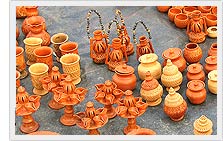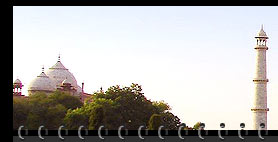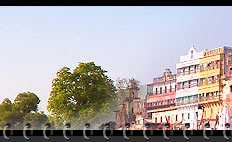Art & Craft in India/ Languages in India
Art & Craft in India

India
is like an enlarging ground where we get to witness innumerable scenes of
culture, art and mother nature. The traditions and customs of India tend to
produce so many activities that are stimulating visually. India Crafts
displays some exclusive pictures related to Indian art and crafts;
traditions and customs and people. Just enjoy the mesmerizing art &craft
and know the real face of India.
In India, art is a like an energy booster. It is a mystical force, which
gives shape to the vision of the artist. It speak volumes of the quickness
and expertness of craftsmanship. For the artists these creations are not
pulse less objects but full of life, carrying their passion and exactness.
You can experience the variety, vibrancy and discreetness of traditional
Indian art and crafts as there are a myriad number of things in terms of
gems of Indian stone work, metal work, jewelry, woodcrafts, leather work,
carpets, pottery, paintings, textile and furniture.
Indian Paintings can be broadly classified as the murals & miniatures.
Murals are huge works carried out on the walls of solid structures. Classic
examples are the paintings in Ajanta & Kailasantaha temple.
Accomplished Artisans of India
India may be a land of farmers but it is equally a land of artisans. Indian
art and craft is the sheer hard work of thousands of unknown unvalued
artisans and crafts persons who create magic with their tricks. They are the
ones who make those fabulous tie-and-dye skirts, those fabulously
embroidered Gujarati cholis, that ornamented furniture and that beautifully
dotted silver jewellery.
Languages in India
India is the home of many languages. India is a huge country with lot of
cultural and geographical differences. There are a number of languages
spoken in India. Some of these languages are accepted nationally while
others are accepted as accents of that particular region. Even the foreign
invasions have left an impact on the Indian local languages. British not
only left their customs and traditions behind but they even left their
language English to become a commonly used official language of India.
The Indian languages belong to four language families: Indo-European,
Dravidian, Mon-Khmer, and Sino-Tibetan. Indo-European and Dravidian
languages are used by a large majority of India's population. The language
families divide roughly into geographic groups. Languages of the
Indo-European group are spoken mainly in northern and central regions.
The languages of southern India are mainly of the Dravidian group. Some
ethnic groups in Assam and other parts of eastern India speak languages of
the Mon-Khmer group. People in the northern Himalayan region and near the
Burmese border speak Sino-Tibetan languages.
Today India has 18 officially spoken recognized languages. They have
evolved from language families drawn from the history. The major ones to
make an influence are the Aryan and the Dravidian.
The largest language that is not one of the 22 "languages of the 8th
Schedule" with official status is the Bhili language with some 5.5
million native speakers (ranked 13th), followed by Gondi (15th), Tulu (19th)
and Kurukh (20th). On the other hand, 3 languages with fewer than 1 million
native speakers are included in the 8th Schedule for cultural or political
reasons: English (40th), Dogri (54th) and Sanskrit (67th).






 India
is like an enlarging ground where we get to witness innumerable scenes of
culture, art and mother nature. The traditions and customs of India tend to
produce so many activities that are stimulating visually. India Crafts
displays some exclusive pictures related to Indian art and crafts;
traditions and customs and people. Just enjoy the mesmerizing art &craft
and know the real face of India.
India
is like an enlarging ground where we get to witness innumerable scenes of
culture, art and mother nature. The traditions and customs of India tend to
produce so many activities that are stimulating visually. India Crafts
displays some exclusive pictures related to Indian art and crafts;
traditions and customs and people. Just enjoy the mesmerizing art &craft
and know the real face of India.